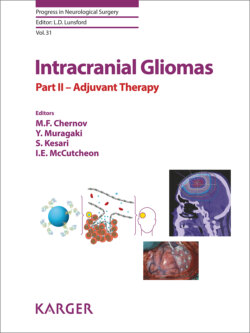Читать книгу Intracranial Gliomas Part II - Adjuvant Therapy - Группа авторов - Страница 51
На сайте Литреса книга снята с продажи.
Dose
ОглавлениеA retrospective analysis was performed on patients treated according to BTSG protocols to evaluate for a dose-effect relationship of FRT on malignant glioma [5]. Increasing doses correlated with improved outcome as patients receiving ≤45, 50, 55 and 60 Gy had median survival of 13.5, 28, 36, and 42 weeks, respectively [5]. In subsequent clinical trials dose escalations beyond 60 Gy in the form of a stereotactic radiosurgical (SRS) boost [6], brachytherapy [7] or additional fractionated radiation [8, 9] have failed to be of benefit.
Hypofractionation utilizes higher than standard doses per fraction and commonly shortens the radiation treatment course. In elderly patients or those with poor performance status, a hypofractionated radiotherapy schedule may be considered. A randomized controlled trial was performed in 100 patients with GBM aged ≥60 years comparing standard FRT (60 Gy in 30 fractions) with a hypofractionated radiotherapy (40 Gy in 15 fractions) [10]. Of note, TMZ was not used in this study. There was no difference in overall survival between the two arms [10]. In a subsequent randomized Nordic trial, 291 elderly patients were randomized to receive standard FRT (60 Gy in 30 fractions), hypofractionated radiotherapy (34 Gy in 10 fractions) or TMZ alone [11]. The hypofractionated arm and chemotherapy-alone arm compared favorably with the standard FRT arm. However, in this study concurrent TMZ was not used in either FRT arm [11].
